PRESIDENT BIDEN SIGNED THE INFRASTRUCTURE BILL on 15 November 2021, where USD 1.2 trillion is going to what is technically known as the Infrastructure Investment and Jobs Act or IIJA and lays out six priorities for the bill’s implementation. I recently spoke to Megan Miller of Deltek, the leading A&E financial software firm and a touchstone for critical industry data, including how the IIJA may impact the AEC industry. One of the essential facts we learned in our hour-long conversation was that A&E firms are projecting an 18 percent growth in estimated net revenues year-over-year, partly due to the passage of the Infrastructure Bill.
“When we look at what we have seen from 2019 to 2020 and till now,” says Miller, “some of what we saw during the pandemic years of 2020 and 2021 was a little bit of uncertainty.” “But from a project perspective—meaning they haven’t seen that growth yet—that’s the projected growth they are reporting they expect to see in 2022 from what they saw the year before.”

Megan Miller, CPSM, Director of Product Marketing at Deltek, talks to Architosh about the Architecture and Engineering industries going forward in the year ahead. (Image: Deltek)
“We believe some of that optimism is due to the Infrastructure Bill, but we also have a strong balance in what we see in our Clarity Report between architects and engineers and the types of work they do,” adds Miller. “We don’t think that optimism is 100 percent attributed to that bill, as we are seeing other markets doing well because of the current context too. We see a boost in industrial and warehousing; we see the commercial and healthcare industry continue to be strong in addition to residential staying at current growth levels.”
Optimism in the A&E Sectors
Miller says that as the year comes to a close in 2022, the optimism has been waning a bit due to the issues with inflation and supply chain matters. Still, even the AIA’s index numbers show strong project inquiry growth in several sectors, like those just mentioned. However, Miller cautioned that due to the negative headwinds of inflation and supply chain issues, some projects are being put on hold because a previous project just finished came in over budget due to inflation or ran over schedule due to supply chain issues. “There are some challenges that some firms are seeing now that may make it more challenging to hit that 18 percent year-over-year growth projection,” she adds, “but we are still optimistic. ACEC’s Positive Sentiment Survey is still quite positive.
We believe some of that optimism is due to the Infrastructure Bill, but we also have a strong balance in what we see in our Clarity Report between architects and engineers and the types of work they do.
Miller says that conversations with customers are also showing evidence of strength in the A&E industry, acknowledging that while working with Deltek on optimizing their processes, which takes time away from projects, they are seeing evidence of a challenging environment to keep up with workloads and opportunities. “They are having challenges with keeping up because they are having challenges finding staff, and there are a lot of work opportunities out there,” she adds. “There are even projects coming from the Infrastructure Bill that some of our clients are seeing coming through that they are working on.”
I asked Miller how much of the Infrastructure Bill may trickle to architects versus engineers. She reported that estimating that percentage is challenging because the government hasn’t broken down such data. “I have spoken with some of our analysts here at Deltek, and they have been having those conversations with customers. We know that certain types of infrastructure assets are earmarked in the Infrastructure Bill, and others are not,” she adds. Roads and bridges are one area with more clarity in the IIJA, but there are also monies allocated for passenger and transport rail and water, which need facilities. “Aviation is a big portion of this infrastructure bill,” she says, “and that is definitely an area where we expect to see more of an impact on the architectural industry.”
Still, the current economic headwinds discussed in the general media would make one think that it doesn’t make sense for the A&E sectors to be so optimistic. However, Miller explained the situation this way: “As we look at some of this optimism, when you have things like IIJA, it creates more optimism across the economy because that money has been designated to help move projects forward,” she says. “And when those projects move forward, it has a ripple effect. So when we have better Infrastructure like better aviation facilities, it can lead to companies wanting better warehousing facilities near those improved aviation facilities, for example. So the potential for that ripple effect coming out of IIJA, a dedicated source of money, is something that really helps with that optimism.”
Aviation is a big portion of this infrastructure bill and that is definitely an area where we expect to see more of an impact on the architectural industry.
Another piece of optimism is likely the sense of the long-term outlook for the infrastructure industries in general, where bills like the IIJA are massive government investments to long-term economic prosperity. In an article from US Wealth Management, Rob Haworth, senior investment strategy director for U.S. Bank, notes, “Infrastructure spending is meant to create a foundation for future growth. This type of legislation is not aimed so much at driving baseline growth today but helping drive potential growth for years to come.”
So despite recent concerned sentiment about a possible mild 2023 recession due to rising interests rates, the funds committed in the Infrastructure Bill (IIJA) both lay a confidence factor under long-term growth as well as spur on ripple effect growth through adjacency private investment to the projects that are underway now and starting in the next few years.
Deltek Clarity Report for A&E
I asked Miller to explain her company’s Clarity Report and what it does.
“Clarity is more of a thought-leadership benchmarking tool for the industry,” says Miller. Deltek Clarity is not a software product per se, but a free report based on Deltek’s vast industry reach and AE firm participation data. As such, the Deltek Clarity report is an excellent tool for assessing trending data for A&E firms from year to year and a way for A&E firms to benchmark themselves against the survey data itself. The current 43rd Annual Deltek Clarity: Architecture & Engineering Industry Study comprehensive report is developed in collaboration with the ACEC, AIA, and SMPS. More than 540 firms participated in the latest study.
“The Deltek Clarity report helps firms determine how they are performing compared to others like theirs in the industry,” adds Miller. A&E firms gain critical insight from the Clarity report, which contains sections on digital technology, business development, project management, and human capital management data and trends. For instance, the latest Clarity report shows that 34 percent of A&E firms plan to invest in Augmented/Virtual Reality; in general, after the more uncertain pandemic years, A&E firms have renewed interest in emerging technology (emTech) with a focus on applying that technology to streamlining project functions.
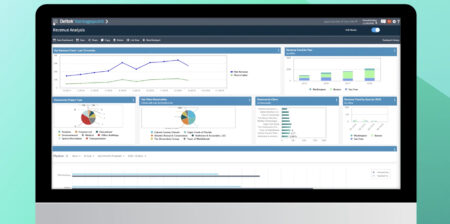
Deltek Vantagepoint is shown here in this view looking at a dashboard-level view of information. (Image: Deltek)
“Inside the report, we are looking at things like what is the average utilization rate for firms that are small versus large,” says Miller, adding the example of “what is the operating profit on net revenue for architecture firms compared to engineering firms?” This is the type of data the Deltek Clarity report provides. Firms use this data to benchmark themselves and set goals. “Financial consultants may aspire for your firm to reach 100 percent utilization,” says Miller, “but organizations know that is not realistic because nobody can work 100 percent of billable hours, so what should that utilization rate be for a firm or the industry or a sector?”
So for firms looking at this Clarity Report data, where Deltek is aggregating survey response data from 500 – 600 architecture and engineering firms across the country, they can benchmark themselves against averages for firms like theirs in terms of size and type. But to do this accurate benchmarking, A&E firms need the right kinds of industry-specific financial and project management tools—the kind Deltek leads in the A&E industry.
Deltek Financial Solutions
Deltek has two primary financial software systems for the architecture and engineering (A&E) industry. Their leading solution, called Deltek Vantagepoint, is purpose-built for medium to enterprise-sized architecture and engineering firms or small firms with demanding financial and project management control needs. Deltek Ajera, a second solution the company acquired several years ago, is aimed at small to medium-sized architecture and engineering firms with less complex requirements. Both solutions provide the KPIs (key performance indicator data) firms need to deliver, compare, and benchmark data against the Clarity Report.
Using financial accounting tools designed to measure the performance of architecture and engineering firms across the key performance indicators (KPIs) is a critical component of A&E firms’ understanding of how to improve their business financials. Without such tools—like when A&E firms use general accounting tools like QuickBooks—A&E firms cannot track key measures. As Keith Granet of Granet Associates says in his book The Business of Design, Balancing Creativity and Profitability, “Many firms use QuickBooks, but the reporting tools are not as detailed as I recommend when managing a design practice.” Solutions designed for the architecture and engineering professions, like Deltek’s software, include project-related reports, project progress reports, time analysis, utilization, and more. In short, from these tools, firms can generate KPIs to track performance in near real-time.
Technology is intricately tied to efficiency in the AEC industry in the modern era. Some architecture firms could be better managed, including firms with world-class reputations for their design prowess.
As Architosh has written about in our monthly newsletter Xpresso, recent unionization movements and revolts by the younger generation of architecture students and professionals have highlighted the exploitative nature of policies that mask a firm’s true economic inefficiencies.
With technology, you get to be on an even footing earlier in the process. So it doesn’t matter whether you are a small or disadvantaged business or an enterprise company; technology helps to level that playing field.
The reality of this unfortunate wave of frustration is significant to discussions about gender equality in the architectural profession, an issue I highlighted in my discussion with Deltek’s Megan Miller. “I actually did a webinar with AIA earlier this year,” says Miller, “one of the things that we talked about was that technology can be, in many cases, the great equalizer.”
“With technology, you get to be on an even footing earlier in the process. So it doesn’t matter whether you are a small or disadvantaged business or an enterprise company; technology helps to level that playing field.”
Miller also noted a recent conversation she had with a customer. “They were saying, ‘what we are seeing with this challenge we are having with staffing, we are not going to be able to fix it by just throwing more people at the problem. We are going to have to find ways to do our work smarter and better,’ ” adds Miller, who says the industry needs to capture the benefits of technology better. “How do we make it so that architects don’t have to work 60 hours a week?” she asks rhetorically.
Architects do not want to work 60 hours per week; that is one of the main complaints brewing up in the many unionization movements Architosh has written about earlier in the year. Part of that issue is policy, culture, and technology.
Force Multipliers via Technology
On the technology side, the answer involves the interplay between technology and management. That’s because the latter is ultimately responsible for the former’s utilization and maximum utility.
A case in point might be the age-old workflow of taking field notes or doing punch lists on job sites. Miller explains: “One of the things Deltek offers is a new tool we acquired called ArchiSnapper, which is a field reporting tool. So how often are we asking architects to go out into the field to do field reports and take pads of paper for notes and little digital cameras and then come back into the office to match everything up?
Instead, ArchiSnapper lets you take a picture, tap where it goes on the floor plan, and use voice to text for your notes. The app does the rest, and you can send your field report out before you even leave the job site,” she says. “Why is the industry not doing more with tools like that?” asks Miller, noting that a tool like ArchiSnapper (and there are others that do very similar things) makes it so an architect can do four site visits a day rather than having four different architects go visit sites in a day.
Another example of a force multiplier applied to a standard workflow that has long resisted common-sense digital conversion is the process of writing specifications. Miller explains. “Just last year, in partnership with AIA, we launched Specpoint, and that is all around digitizing the construction specification process and getting all of the different partners in one place so they can build that specification package, rather than having the stacks of binders, having to take my Word document and your Word document and trying to put them together, and making it easier to find the right building product manufacturers in a place where I don’t have to spend hours doing all of my own research because someone else has already done that research for me.”
Indeed, Specpoint, which is home to the AIA MasterSpec, is in the vein of new 2-sided and 3-sided market platforms that are convergent solutions that bring different sides of the AEC market together into a single place online or inside apps where data silos are broken down, collaboration can be streamlined, and where different sides of the market can reach each other more efficiently and eliminate wasteful processes associated with antiquated ways of working.
AI and Future of AE Firm Tech Stacks
And speaking of “antiquated ways of working,” I could not leave my conversation with Megan Miller and not ask about time cards and filling them out manually when it is entirely possible for artificial intelligence (AI) to learn how to watch us work and figure out what we are working on and for how long and track this data for us, so we don’t need to sweat the details of inaccuracy and generally disrupt our workflows to track this data.
“This is a discussion we have a lot, and it’s one of the biggest questions,” says Miller. “And it’s because if I go and talk to somebody and say ‘I work for Deltek,’ they will say ‘oh, you are the timesheet people,’ because that is what they think of us.”
So I don’t have to go look up the project, make sure I have the right phase and tasks—because that’s what project managers spend a lot of time on—it is already done for me, and I can quickly just confirm that data for my timesheet.
“Yes, the timesheet is the thing everyone touches in architecture and engineering firms. And there are things, especially in Vantagepoint, to make that easier, says Miller. For example, she adds, “things like one—being able to do resource planning for the project to start with. I am assigned from the outset for the project for the weeks I need to work on it, and I know how many hours I am supposed to work on it.” Miller says that you can put those assignments on your calendar to plan your work week, and it’s a drag-and-drop process. “And all you have to do is click on it and say ‘yes I did this,’ and the time data is automatically correlated onto my timesheet.”
“So I don’t have to go look up the project, make sure I have the right phase and tasks—because that’s what project managers spend a lot of time on—it is already done for me, and I can quickly just confirm that data for my timesheet.”
Miller says that companies need to fully utilize the tech stacks they already have and obtain the right tech tools. “We have mobile tools that enable engineers and architects to fill in their timesheets from anywhere, including the job site,” she adds.
Agile and Order to the Process
Megan Miller says Deltek offers to bring order to the process of practice for firms in the A&E industry. This isn’t just about delivering the A&E industry’s best-regarded financial software tools purpose-built for architecture and engineering. It is about leveraging industry data so firms can use those same financial tools to monitor and benchmark their workflows and processes so they can “learn from doing” and make steady progressive improvements year to year.
Learning from doing is recognized as a critical component of what is known as Wright’s Law, and the technology investment firm ARK Invest has the best explanation of Theodore Wright’s forecasting framework explained here. While studying airplane manufacturing, Wright determined that the labor requirement was reduced by 10-15 percent for every doubling of airplane production. Wright’s Law applies to all manufacturing or processes where “learning by doing” provides critical insight from which processes are improved. The improvement percentage numbers may vary by industry, but generally, learning by doing, when properly captured into a feedback loop that informs future change, brings about steady and predictable efficiency gains.
The difference between the A&E industries and the software industry examples you just discussed is that there are very few project managers in A&E firms who didn’t come from being designers and engineers first, and that is what they default back to in times of staff shortages.
Interestingly, despite the power of computers, software, and the power of the Internet, the AEC industry’s real gross value added per hour worked has grown at a quarter of the rate of manufacturing, according to this article in The Economist.
How can two industries that are fundamentally about designing and making stuff be so far apart on productivity curves?
While we at Architosh are exploring that big question across multiple dimensions—from culture and the academy to lack of digitization in the AEC as a whole, to industry lock-in and poor industry data interoperability—Miller’s response to this industry-wide problem touches on a crucial issue that keeps popping up. For the AEC industry to make critical changes to the process that could manifest positive economic and productivity improvements at the same rate of progress as manufacturing, there needs to be time devoted to capturing learning by doing lessons. Otherwise, the manufacturing world will continue to have its Wright’s Law, and the AEC world will continue to have no law and poor relative productivity measures.
Miller says that the current challenge due to staff shortages is that the project managers who plan out projects at the highest level with financial goals and improvement ambitions built into scenarios are now being forced to roll up their sleeves and design and document projects.
“The difference between the A&E industries and the software industry examples you just discussed is that there are very few project managers in A&E firms who didn’t come from being designers and engineers first, and that is what they default back to in times of staff shortages,” says Miller.
The implication that the AEC industry could learn from manufacturing and software agile management practices is that the labor component in A&E firms would contain essential project management layers that only do project management functions (and never anything else) and could capture learning by doing feedback loop data and put it into process improvements.
“We have actually had conversations here at Deltek—not about doing things exactly how they are done in the software industry—but changing that mentality in A&E firms to that agile management framework,” says Miller.
“There is a lot in there where the A & E industries can benefit from thinking about how agile project management can be instructive….because, again, not everything is linear.
“Again, thinking about Deltek Vantagepoint…not only do we have Gantt charts, which everybody needs to have to see how the schedule builds out visually,” says Miller, “but we are also bringing forward schedule dependencies so that if one process shifts then everyone knows what the impacts are, and the software updates every line automatically.”
Final Thoughts
At the beginning of this article, we learned that the Infrastructure Bill (IIJA) is a critical factor in A&E industry optimism and an acting factor contributing to projected A&E firm growth in the immediate term. It means, in short, that the United States will have a backlog of infrastructure and facilities projects coming online for nearly a decade and that investment in Infrastructure boosts efficiencies in the work that Infrastructure provides to other industries. A better airport can spur new demand for companies to build warehousing in new locations, distribute their hubs and shorten customer delivery cycles.
These new projects and work are also arriving parallel to the Baby Boomer generation’s planned retirement, and staff shortages in AE firms are already manifesting across the industry. The solution to this new pinch-point will be challenging to execute when project managers and even firm principals must roll up their sleeves to make work happen and hit deadlines. The AE industry must take stock of how powerful digital tools paired with well-honed management processes can deliver new levels of efficiency and a sense of control. Deltek’s industry-leading software tools and Clarity report are critical first steps in this process.

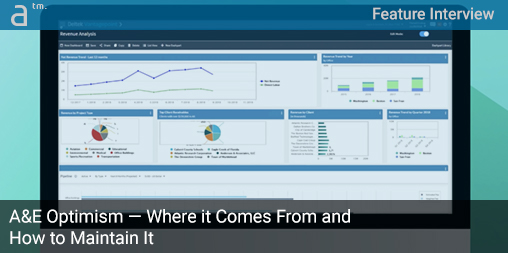
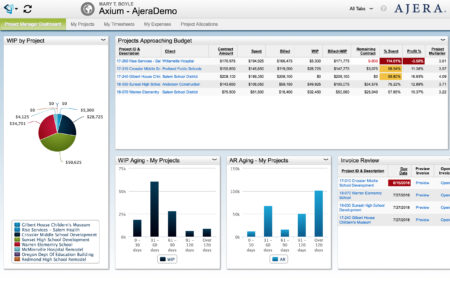
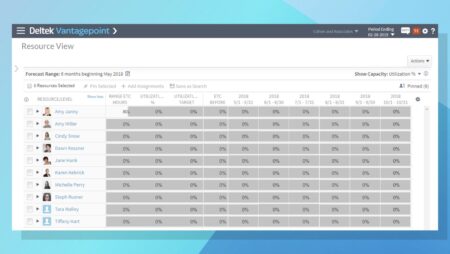
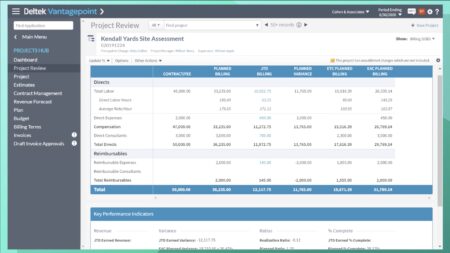
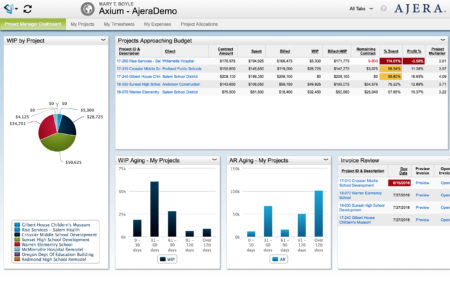


Reader Comments
Comments for this story are closed